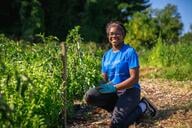You have /5 articles left.
Sign up for a free account or log in.

Istockphoto.com/frantic00
Most college students are working as they study, but the amount and type of work varies widely. And the forces behind those variances aren't random.
Low-income working students tend to work longer hours than their high-income counterparts. They also are more likely to be black or Latinx, older and female, according to a 2018 report from the Center on Education and the Workforce at Georgetown University.
“To me, it boils down to the story of how higher ed is compounding social inequity,” said Lindsay Ahlman, associate director of research at the Institute for College Access and Success.
The Georgetown report found that 70 percent of full-time college students are working. While more students are working, the number working full-time has decreased, from 40 percent in the late 1980s to 26 percent in 2012.
Still, low-income working students are more likely to work full-time than those who are high income (26 percent versus 22 percent). The majority of students across income brackets are working 15 to 35 hours per week.
Previous research has shown that, while working can be beneficial for students, there is a threshold where it starts to do more harm than good. Students who work 15 hours or more per week are more likely to have a C average or lower, while those who work less than 15 hours are more likely to have a B average or higher.
Students who work less also are more likely to be enrolled in bachelor’s degree programs, versus associate degree and certificate programs.
Working experiences also vary depending on students’ incomes. For high-income students, their work is more likely to connect to longer-term professional and academic goals.
To Ahlman, the research on working students is an example of the different experiences students are having based on their incomes.
“The type of privileges you enter college with tend to compound in college,” she said. Low-income students tend to work to put food on the table, she said, while high-income students use work to pursue passions and interests.
Working while in college has become a way for some students to “give themselves an edge,” said Nicole Smith, chief economist at the Center on Education and the Workforce and co-author of the report.
“We have to be really careful about understanding work,” she said. “We know that everyone’s doing it. Now that we know, we have to make better decisions on how we connect students to work.”
And while working can hurt a student’s ability to complete a degree, it can also boost earnings. Daniel Douglas, a senior researcher at Rutgers University and visiting assistant professor at Trinity College in Connecticut, studied how working in college affected future earnings for students at the City University of New York.
The research controlled for race, Pell eligibility, major, time enrolled and time since enrollment, among other factors, and found that, all things being equal, working in college leads to earnings premiums later. This held true for students who stopped out of college, as well.
Still, Douglas said, the research showed that the “optimal outcome is a student who works but also graduates.”
There are several theories that could explain this outcome, he said, from signaling to employers that you have a work history, development of soft skills or the “grit hypothesis” -- that those students are better at time management, Douglas said.
While his research presents a silver lining for working students, Douglas said it can’t inform what students should do.
“Interviews with community college students suggest that they don’t have ability to make that decision anyway,” he said. But if working is going to help students and is necessary, institutions could try to find ways to support them in that, he added.
Many community colleges are already connecting with businesses to focus on what skills students need for their jobs, Smith said, but some institutions are focused “solely on learning” and “creating good citizens.”
But, she said, they need to think of Maslow’s hierarchy of needs. Getting a job isn’t irrelevant, she said; students need to be able to put food on the table before they can focus on loftier ideas.
“This is one of the reasons that for-profit institutions were so successful in recruiting,” Smith said. “Not because they did what they said they’d do, but they were marketing what many of our institutions didn’t do -- training for specific jobs.”
Smith is an advocate for talking with students as early as middle school about financial literacy issues. Those without the social capital of high-income peers may shy away from loans and opt to work full-time while in school instead, she said.
“It’s really a matter of trying to get people to understand you could be shooting yourself in the foot and making yourself worse off by not completing degree,” she said.
Instead, counseling on the impacts of borrowing could ease some of that stress.
Smith sees the momentum of institutions pointing in a positive direction, too, toward building a “superhighway” between high school, college, career and lifelong learning that breaks down traditional silos by guiding students on their way to getting a degree.
Ahlman also supports breaking down silos by helping students both in academic and nonacademic ways, like helping those eligible enroll for food stamps. In addition, she said the government should take steps to make college more affordable.
“No student should have to choose between putting food on the table and studying, but that’s what we’re asking.”




